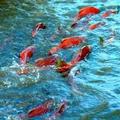 環保以及漁業團體於2月4日在加州高等法院提出訴訟,希望能迫使州及地區水利會於加州北海岸區域野外的河流及溪流,實際執行現有淨水法的規定。
環保以及漁業團體於2月4日在加州高等法院提出訴訟,希望能迫使州及地區水利會於加州北海岸區域野外的河流及溪流,實際執行現有淨水法的規定。
這些團體指出,唯有乾淨的水才能讓瀕危的鮭魚物種族群恢復。
加州北岸河流和溪流長年來因淤積、營養物、高溫、低溶氧、混濁等因素而使得水質敗壞。這些污染都是因為建造水壩、水流改道、都市發展、農業、伐木、採礦和放牧所造成的。
河流與溪流水質情況衰敗,使得該地區鮭魚的存活率受到衝擊,包括名列聯邦瀕危動物法案的國王鮭魚、銀鮭、和北加州的鋼頭鱒。
2008年西岸的鮭魚數量大減,導致商業鮭魚垂釣季破天荒地停辦。
在這項議題中,行動計畫是淨水法案中每日最大量計畫(TMDL)的一部份,TMDL是水體在24小時內,於符合水質標準之下可接受最多污染物的量。
這項計畫首先必須有當局去測定及照理受創河川或溪流的名錄,並向美國環保署申請認可。
接下來,當局必須確定違反法規的污染物來源為何,並對這些污染源設定TMDL限值,以及發展行動計畫來使水質能達到標準。
但除了加西亞河,斯科特河,以及沙斯塔河外,北海岸地區水質管制局與州立水資源管制局尚未如州立水質管控法案及聯邦淨水法所要求的──對其他的河流立出行動計畫。
由這些團體的投訴中可知,他們知悉北海岸地區水質管制局大幅削減與潔淨水源計畫相關之人員編制與經費。
Conservation and fishermen's groups filed a lawsuit Wednesday in California Superior Court seeking to force state and regional water boards to implement existing clean water laws in the wild rivers and streams of the state's North Coast region.
The groups argue that only cleaner waters will enable the recovery of endangered salmon species.
For decades, water quality in North Coast river and streams has been degraded by sediment, nutrients, high temperatures, low dissolved oxygen levels, and turbidity. These pollutants are the result of dam construction, water diversions, urban development, agriculture, logging, mining, and grazing.
The declining river and stream conditions have impacted the survival of regional salmon species, including chinook salmon, coho salmon, and Northern California steelhead, which are now listed under the federal Endangered Species Act.
Last year, the collapse of salmon stocks on the west coast caused the first ever complete shutdown of the commercial salmon fishing season.
The action plans at issue are part of the Clean Water Act's Total Maximum Daily Load, TMDL, program. A TMDL is the maximum amount of a pollutant that a waterbody can receive in 24 hours and still meet water quality standards.
The program first requires the agencies to identify and maintain a list of impaired rivers and streams and submit that list to the U.S. EPA for approval.
The agencies must then assess the sources of pollution causing the violations, set TMDL limits for these sources, and develop action plans to achieve the standards.
But except for Garcia River, Scott River, and Shasta River, the North Coast Regional Water Quality Control Board and the State Water Resources Control Board have failed to prepare action plans as required by the state Porter-Cologne Water Quality Control Act and the federal Clean Water Act.
In their complaint, the groups recognize that the North Coast Regional Water Quality Control Board, has suffered from deep cuts in staffing and funding for clean water programs.




